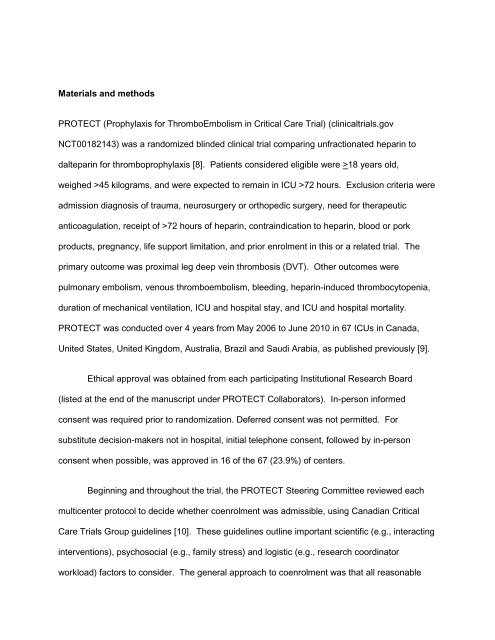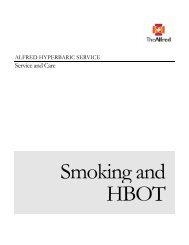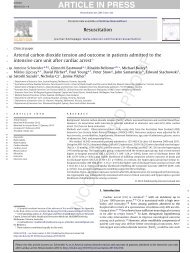Critical Care
See Full Article - Alfred Intensive Care Unit
See Full Article - Alfred Intensive Care Unit
- No tags were found...
Create successful ePaper yourself
Turn your PDF publications into a flip-book with our unique Google optimized e-Paper software.
Materials and methods<br />
PROTECT (Prophylaxis for ThromboEmbolism in <strong>Critical</strong> <strong>Care</strong> Trial) (clinicaltrials.gov<br />
NCT00182143) was a randomized blinded clinical trial comparing unfractionated heparin to<br />
dalteparin for thromboprophylaxis [8]. Patients considered eligible were >18 years old,<br />
weighed >45 kilograms, and were expected to remain in ICU >72 hours. Exclusion criteria were<br />
admission diagnosis of trauma, neurosurgery or orthopedic surgery, need for therapeutic<br />
anticoagulation, receipt of >72 hours of heparin, contraindication to heparin, blood or pork<br />
products, pregnancy, life support limitation, and prior enrolment in this or a related trial. The<br />
primary outcome was proximal leg deep vein thrombosis (DVT). Other outcomes were<br />
pulmonary embolism, venous thromboembolism, bleeding, heparin-induced thrombocytopenia,<br />
duration of mechanical ventilation, ICU and hospital stay, and ICU and hospital mortality.<br />
PROTECT was conducted over 4 years from May 2006 to June 2010 in 67 ICUs in Canada,<br />
United States, United Kingdom, Australia, Brazil and Saudi Arabia, as published previously [9].<br />
Ethical approval was obtained from each participating Institutional Research Board<br />
(listed at the end of the manuscript under PROTECT Collaborators). In-person informed<br />
consent was required prior to randomization. Deferred consent was not permitted. For<br />
substitute decision-makers not in hospital, initial telephone consent, followed by in-person<br />
consent when possible, was approved in 16 of the 67 (23.9%) of centers.<br />
Beginning and throughout the trial, the PROTECT Steering Committee reviewed each<br />
multicenter protocol to decide whether coenrolment was admissible, using Canadian <strong>Critical</strong><br />
<strong>Care</strong> Trials Group guidelines [10]. These guidelines outline important scientific (e.g., interacting<br />
interventions), psychosocial (e.g., family stress) and logistic (e.g., research coordinator<br />
workload) factors to consider. The general approach to coenrolment was that all reasonable









